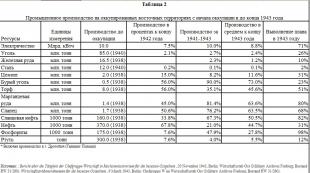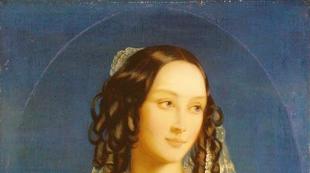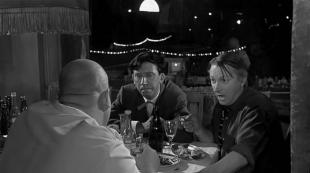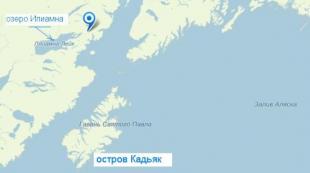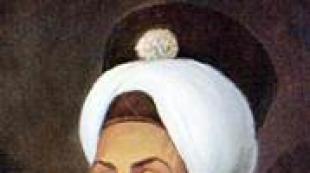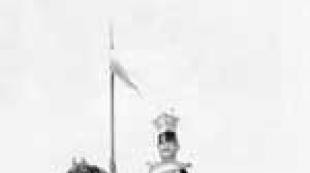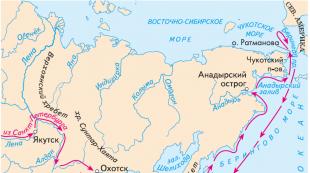Where is Norway located on the world map? Norway Norway map with cities and fjords
Norway - country in northern Europe, the main part of which is located in the western part of the Scandinavian Peninsula.
The territory of Norway includes approximately 50,000 small coastal islands, as well as the large Svalbard archipelago, Bear Islands and Jan Mayen Islands in the Arctic Ocean. On a detailed map of Norway, you can find the country's border with three states: with Sweden in the east, with Finland and Russia in the northeast.
Norway is one of the largest oil and gas producers in Europe and a global exporter of timber, titanium and fish.
Norway on the world map: geography, nature and climate

Norway on the world map is located in Northern Europe, in the west of the Scandinavian Peninsula, washed by the waters of the North Sea from the south, Norwegian - from the west, Barents - from the north.
Minerals
The country has large reserves of oil and gas, iron, titanium and zinc. In smaller volumes, there are also deposits of lead, copper, coal, apatite and graphite.
Relief
Most of the territory of Norway is occupied by the Scandinavian mountains with numerous fjords (bays deep into the land with rocky shores) and valleys. The northern and southern part of the country is occupied by elevated plateaus - fjelds - Yuste-dalsbrs, Telemark, Yutunheimen, in the last of which the highest point of Norway is located - Mount Gallhøpiggen (2470 m).
Hydrography
The river network of Norway is dense, and the rivers themselves are full-flowing, deep and narrow. The rivers are fed by snow-rain or ice. The longest river is the Glomma (619 km), flowing through the east of the country.
About 4 thousand Norwegian lakes occupy 5% of the country's area and are located mainly in southern Norway. The largest lake is Mjosa with an area of 365 km 2, located on the map of Norway in Russian in the southern part of the country, 100 km north of the capital Oslo.
There are almost 900 glaciers on the territory of the country, most of which also occur in Southern Norway.
Flora and fauna
Norwegian soils are not very fertile. The most common types of soils are: mountain-meadow, low-humus podzols, podzols, brown, marsh gleyed and others.
There are mixed broad-leaved forests, taiga and coniferous-broad-leaved forests, mountain forests and tundra vegetation in the country. Forests occupy 27% of the country's territory, they grow: oaks, beeches, ash trees, birches, spruces, mosses and lichens.
Lynxes, deer, martens, ermines, squirrels, bears, hares and foxes are found in local forests and tundra; and among the representatives of birds - capercaillie, black grouse, gulls, geese and other birds. Fish of the salmon family live in fresh water, and herring, mackerel, and cod live in sea water.
The protected areas of Norway include 37 national parks, several nature reserves and about a hundred wildlife preserves.
Climate
Norway's climate varies from mild temperate maritime in the south, temperate continental in the center, to subarctic in the very north of the country. The climate of Norway is significantly softened under the influence of the warm currents of the Atlantic and Arctic Oceans, characterized by mild, for such high latitudes, winters and cool summers. The average January temperature in Norway ranges from -17°C in the far north to +2°C in the southwest of the country, while the average July temperatures range from +7°C to +17°C respectively. Cloudy and rainy weather prevails in Norway - approximately 800 - 1200 mm of precipitation falls annually.
Map of Norway with cities. Administrative division of the country

Norway consists of 19 counties (provinces, counties), and is also unofficially divided into 5 regions:
- Southern Norway,
- Northern Norway,
- Western Norway,
- Eastern Norway,
- Central Norway.
Largest cities
- Oslo- the capital and most important city of Norway, located on the banks of the Oslo Fjord, in the southeast of the country. Oslo is a major seaport and center of the oil and gas industry, as well as one of the most expensive cities in the world. Akershus Fortress, built in the 13th century, is the main attraction of the city. Oslo is home to 673,000 people.
- Bergen- the second largest city in the country, which on the map of Norway with cities in Russian can be found in its western part. Being on the coast of the North Sea determines the main specialization of the city - maritime business and maritime research (oceanography). The population of Bergen is 273 thousand people.
- Alesund- Another city on the west coast of Norway, the largest center of the country's fishing industry. Three kilometers west of Alesund, there is a large aquarium, which clearly shows the life of the marine inhabitants of the North Atlantic in the most natural conditions - cod, eels, halibut and other fish - because the water comes directly from the sea. The population of the city is 42 thousand people.
Where is Norway located on the world map. Detailed map of Norway in Russian online. Satellite map of Norway with cities and resorts. Norway on the world map is a country in the northwest of the Scandinavian Peninsula, the northern part of which lies beyond the Arctic Circle. Norway is washed by three seas at once: the Barents, Norwegian and North. The capital is the city of Oslo. The official language is Norwegian.
Map of Norway in Russian with cities detailed:
Norway - Wikipedia:
Population of Norway- 5 295 619 people (2018)
Capital of Norway- Oslo
Largest cities in Norway- Oslo, Bergen, Trondheim, Stavanger
Phone code of Norway - 47
Languages spoken in Norway- Norwegian, Bokmål, Nynorsk
The main part of the country's territory is occupied by the Scandinavian mountains and taiga forests. In the Norwegian mountains, you can still find glaciers, which are the largest in the world.
Climate in Norway depends on the region. In the west, the climate is temperate, in the north - subarctic, very severe. In the central part of Norway dominated by temperate continental. Average winter temperatures in January are -4…-8 C. In summer it is much warmer - +17…+19 C.
To see attractions in norway and get acquainted with the history of the country, it is better to go to the city of Bergen. This is not only a city that has preserved many historical monuments, but also a very picturesque place in Norway. Bregen became famous thanks to the Bryggen embankment, which is on the UNESCO World Heritage List, the Bergenhus fortress, the old fish market and the Art Museum, which houses unique works by Picasso, Miro and other creators.
Of the natural attractions of Norway, it is worth mentioning the Svalbard archipelago with nature reserves, the North Cape - the northernmost European point and the country of the Troms Islands.
Tourism in Norway It's definitely skiing. The most popular ski resort among Norwegians and Europeans is Lillehammer, which was the capital of the 1994 Olympic Games. Winter resorts such as Gausdal, Gala, Kvifjell and others are also popular. The infrastructure at all resorts is highly developed, each of them has a rich variety of entertainment for both adults and children.
What to see in Norway:
Oslo Cathedral, Bergen Cathedral, Nidaros Cathedral, Tromsø Arctic Cathedral, Oslo Viking Ship Museum, Bergen Art Museum, Bodo Aviation Museum, Oslo Kon-Tiki Museum, Akershus Fortress, Alpina Arktika Botanical Garden, Vigeland Sculpture Park, Ulriken Cable Car, Northern Lights, Bergen Aquarium, Troll Road, Lofoten, Geiranger Fjord, Kristiansand Dyrepark Zoo and Amusement Park.
| Map of Russia | Italy map | Germany map | Israel map |
| Spain map | Turkey map | USA map | Armenia map |
NORWAY
(Kingdom of Norway)
General information
Geographical position. The Kingdom of Norway occupies the western and northern parts of the Scandinavian Peninsula, the Svalbard archipelago (including Bear Island) in the Arctic Ocean and Jan Mayen Island in the North Atlantic Ocean. Norway is washed by the North and Norwegian Seas, and has land borders with Finland and Russia in the northeast and with Sweden - almost along the entire length of the country from south to north - in the east.
Square. The territory of Norway occupies 323,758 sq. km
Main cities, administrative divisions. The country is divided into 18 counties, which are governed by governors. Traditional division: Northern Norway, which includes three historical and geographical regions: Nordland, Troms and Finnmark, and Southern Norway, which includes four regions: Trennelag, Vestland (West), Esgland (East) and Serland (South).
Political system
State structure: hereditary constitutional monarchy. The head of state is the king, legislative power belongs to the Storting, elected for 4 years.
Relief. Most of the territory is occupied by the Scandinavian mountains with the highest mountain Galdhepiggen (2469 m). The steep northwestern and western slopes of the mountains are dissected by fjords (glaciated and then flooded river valleys, most characteristic of Norway) of the North and Norwegian Seas, while the gentler eastern slopes are cut by deep valleys such as the Österdal. The longest and most branched fjords in Vestland: Sognefjord (204 km), Hardangerfjord (179 km). The south of Norway is occupied by high plateaus (fjelds - plateau-like summit surfaces of the mountains of the Scandinavian Peninsula, covered with tundra vegetation or glacier caps) Telemark, Yutunkhemen and others, and in the north there is the Finmarken plateau.
Geological structure and minerals. On the territory of Norway there are deposits of oil, natural gas, iron ore, copper, nickel.
Climate. The climate of Norway is temperate oceanic, and in the far north - subarctic. The average January temperature is from +2°C on the south coast to -12°C in the fjelds (January frosts down to -40°C occur in the interior of Northern Norway); July - respectively from + 15 ° С to + 6 ° С. Summer on the coast is cool, windy and rainy. On the western slopes of the mountains, precipitation is 2000-3000 mm per year, in the east and in Finnmarken - 300-800 mm.
Inland waters. Due to the mountainous terrain, the rivers are full of rapids and abound in waterfalls. The largest river in Norway is the Glomma, 611 km long (12 km from the mouth there is a waterfall 22 m high). More than 200,000 lakes, mostly small ones, occupy about 4.5% of the country's territory.
Soils and vegetation. Forests occupy more than a quarter of the country's territory: mainly taiga and mountain coniferous (spruce, pine, and above 1,100 m in the south and below 300 m in the north - birch); in the extreme south - broad-leaved (there are beech and oak forests). In the north and the tops of the fjelds, tundra and forest-tundra predominate.
Animal world. In the Norwegian forests are found: elk, red deer, lynx, marten, weasel, badger, beaver, ermine, squirrel; in the tundra: reindeer, white and blue fox, lemming (Norwegian mouse). Hare and fox are found everywhere in large commercial quantities, wolf and bear are practically exterminated. There are a lot of birds in Norway: black grouse and capercaillie, gulls, eiders, wild ducks and geese. Huge bird colonies form noisy "bird colonies" on the coastal cliffs. In the usually calm and shallow (from 70 to 300 m) sea, there are many fish. Traditionally commercial species of fish: herring, cod, mackerel. Salmon, salmon, trout are found in rivers and lakes.
Population and language
With a population of just over 4 million people, 98% are Norwegians. Of the national minorities, the largest are the Sami (about 30 thousand) and the Kvens, the Norwegian Finns. A small number (only about 20 thousand) of emigrants from England, Iceland, the USA are highly qualified specialists. The language is Norwegian.
Religion
Protestants - 95%.
Brief historical outline
The first people on the territory of modern Norway appeared more than ten thousand years ago with the end of the Ice Age.
Of the ancient authors about Norway - "Nerigon", Pliny the Elder mentions, however, as an island on the edge of the earth. Runic (Germanic) inscriptions date back to the 3rd-4th centuries. ad. The special dissection of the relief also contributed to the isolation of the tribes living in Norway. In addition to the Germans, Finnish-speaking tribes also lived here. Written evidence of the 9th century. confirm that the Norwegians not only traded with the Sami, but also subjugated them.
The time of the Vikings (ancestors of the Norwegians) is usually counted from their attack on the Lindisfarne Monastery in England in 793, at that time the property stratification of the community took place, the tribal system disintegrated, the leaders-kings stood out, with their squads, the tribal nobility-yarls took shape. Strengthening their power, the kings became specific rulers. ,
At the end of the ninth century King Harald the Shaggy (later they began to call him Beautiful-Haired) united the small tribes by force and imposed taxes and duties on them, which, even during the life of Harald, led to a mass flight of the nobility and free community members to the North Atlantic islands (Orkney, Hebrides, Shetland and Iceland ).
By the X century. four intertribal formations are formed - tings (gatherings of free community members), who approved the laws, ruled the court, and decided questions of war and peace.
In the X century. Norwegians adopt Christianity, which spread throughout the country under King Olaf II the Holy (1016-1028).
In the XII century. the warlike Viking Age gave way to a more peaceful trading period.
In the XIII century. the two-century process of the unification of Norway ended and the state code of laws - Lannslov was adopted. By the end of the reign of Haakon the Old, Norway, which already owned the Faroe Islands (since 1035) and other islands in the North Atlantic, annexed Iceland and Greenland (1263).
The period of Norway's power was short-lived. With the strengthening of the trade union of the German Hansa merchants, the country is weakening.
In 1266 the Hebrides were lost in the war with Scotland.
In the XIV century. the country loses its independence with the conclusion of separate alliances with Sweden (1319) and Denmark (1380). The severity of the situation was aggravated by the plague that broke out in the middle of the XIV century. and destroyed almost two-thirds of the population. The dependent position of Norway is strengthened with the signing of the Kalmar Union in 1397. The Kalmar Union is a union of Denmark, Sweden and Norway under the auspices of Denmark.
In 1468, Scotland conquered the Shetland and Orkney Islands (with a Norwegian population) from Norway.
In 1523 Sweden withdrew from the Kalmar Union, and in 1537 Norway became a Danish province; Denmark received the last Norwegian possessions in the North Atlantic - Greenland, Iceland and the Faroe Islands.
In the XV century. Norwegian written language is gradually being replaced by Danish.
In 1536, Denmark carried out the Reformation in Norway; Danish, replacing Latin, became the official church, and then the literary language. In developed regions (especially around Oslo), a Danish-Norwegian mixed dialect developed, which developed in the late Middle Ages into the literary Norwegian language - riksmol (literally - "state language") or Bokmål ("book language").
At the end of the XV century. The first university of the Danish-Norwegian state was opened in Copenhagen (the capital of modern Denmark). The first famous Norwegian scientists were the physicist and mathematician Jene Kraft and the mathematician Kaspar Wessel. In the XVII-XVIII centuries. colleges were opened on the territory of Norway itself: the Free Mathematical School in Christiania - the future of Oslo (later the Norwegian Military Institute) and the Mining Seminary in Kongsberg.
In the middle of the XVII century. The collapse of the Hanseatic League and the English Navigation Act of 1651, which limited the rights of Dutch intermediaries, contributed to the development of the Norwegian economy. Norwegian merchants began to freely export timber to England on their ships. The ancient art of the Norwegians also developed - iron smelting
from swamp, and then seam ore. Copper mines were developed, metallurgical and copper-smelting plants were built.
In 1809, the Norwegian Welfare Society was founded, which became the core of the national liberation movement, the growth of which was facilitated by the development of the economy.
In 1811, a Norwegian university was established in Christiania (with the money collected by public subscription).
In 1814, by decision of the countries of the anti-Napoleonic alliance, Norway was transferred to Sweden, which caused an open struggle of the Norwegians against Swedish rule. The Constituent Assembly in Eidsvoll proclaimed the first constitution of an independent Norwegian state, but the sovereignty of Norway was curtailed, and the functions of the Norwegian king were performed by the Swedish king. The Eidsvoll constitution, with some changes, is valid in Norway to this day, and the day of its adoption is May 17, 1814. - is a national holiday.
The struggle against Swedish rule was led by the Norwegian supreme representative body, the Storting, which relied on the peasantry and abolished titles of nobility in Norway, the land tax, which approved the law on local self-government. In 1873, the post of the Swedish governor in Norway was abolished, and in 1855 the Lannsmol language (literally, “the language of the country”, “rural language”) received the rights of the literary and state language along with Rixmol.
On June 7, 1905, the Storting adopted a resolution on the termination of the union with Sweden, approved by a referendum in August of the same year. The Danish Prince Charles, who took the name Haakon VII, was elected King of Norway.
At the beginning of World War II, Norway again declared neutrality, but on April 9, 1940, Nazi Germany attacked Norway.
On June 7, 1940, the king and government, together with the country's gold reserves, moved to Great Britain and organized a government in exile.
For five years, Norway was ruled by the puppet pro-fascist government of Quisling, and a nationwide resistance movement unfolded in the country, which, together with the landing forces of the Norwegian and allied armies, fought against the invaders.
In the autumn of 1944, the liberation of the country began in the course of the Petsamo-Kirkenes operation jointly with the Soviet troops.
King Haakon died on 8 1957, his son Olaf V ascended the throne, who successfully ruled the country and was very popular among the people.
In 1991, after the death of Olaf V, his son Crown Prince Harald (Harald V) ascended the throne.
Brief economic essay
Norway is a highly developed industrial country. Extraction of oil and natural gas (in the Norwegian sector of the North Sea), coal (in Svalbard), iron and titanium ores. Ferrous and non-ferrous (aluminum, nickel, magnesium, zinc) metallurgy; production of ferroalloys. Electrochemistry, mechanical engineering (including shipbuilding, production of offshore oil drilling platforms, electrical engineering and radio electronics), woodworking, pulp and paper, and fish processing industries are developed. The basis of agriculture is meat and dairy cattle breeding; sheep and pigs are also bred. Grain crops (mainly barley, oats) and fodder grasses are cultivated. Forestry, logging. Fishing. Export: oil and natural gas, products of shipbuilding, pulp and paper and chemical industries, metals, fish products. The monetary unit is the Norwegian krone.
A Brief Outline of Culture
Art and architecture. Oslo. Museum of Ethnography; museum of paleontology; museum of mineralogy; National Gallery; Frogner Park (about 150 works by the sculptor G. Vigeland).
The science. K. Guldberg (1836-1902) - physicist and chemist who established the law of mass action; V. Goldshmidt (1888-1947) - geochemist, one of the founders of geochemistry and crystal chemistry; J. Bjerknes (1897-1975) - one of the founders of the theory of atmospheric fronts; F. Nansen (1861-1930), explorer of the Arctic; T. Heyerdahl (b. 1914) - ethnographer and archaeologist, famous traveler; R. Amundsen (1872-1928) - polar explorer, the first to reach the South Pole; O. Hassel (1897-1981) - chemist, one of the founders of conformational analysis.
Literature. G. Ibsen (1828-1906) - playwright, one of the founders of the national Norwegian theater ("A Doll's House", "Ghosts", "Gedda Gabler").
Music. E. Grieg (1843-1907) - composer, pianist, conductor, the largest representative of the national school of composers, who vividly implemented Norwegian musical folklore in his compositions.
Norway is deservedly considered one of the most beautiful countries in Europe. More than ten centuries ago, the country got its name due to its geographical location - "The Road to the North". The capital of the country is washed by the Barents Sea, the extreme point of the Arctic Ocean. At the word , different associations arise, but they are all associated with snow, cold, Vikings and New Year's miracles.
Everyone who has visited Norway notes the hospitality of the locals, interesting and informative museum expositions, cozy and compact cities, and comfortable ski resorts. Norwegian cuisine has a unique taste. The country is still a constitutional monarchy, which is a special pride of the Norwegian people.
A bit of geography
Where is Norway located on the world map? What kind of country is this and why is it so popular with travelers?
Norway is a country on the Scandinavian Peninsula, has the islands of Bear and Jan Mayen. The state borders on such neighbors as Sweden, Russia, Finland. The coastline of the country exceeds twenty-five thousand kilometers. The area of Norway is a little less than four hundred square kilometers.
The capital of the state is Oslo. The official language is Norwegian. Currency - Norwegian krone.
Most Norwegians live in cities.
The third part of the country's territory lies on a hill, more than half a kilometer above sea level.
The unique flavor of Norway
Each country has something special, its own - unique and original. Norway is a fabulous country that enchants children and adults with its color.
Norway is one of the five richest countries, and not only in terms of living standards or incomes of the population, it is rich in its history, culture, and sights.
Everyone can come here on an excursion: lovers of outdoor activities or those who prefer to learn history, couples with children or single travelers. Here everyone will find something that will touch the strings of his soul and will never be forgotten.
Norway is a country with a cold climate, but very friendly people.
The country of sea bays, crashing into the land - fjords - will not leave indifferent fans of extreme recreation. Here you can engage in climbing, fishing, camping or hunting.
Norwegians are very law-abiding people with a minimum number of crimes: doors are not locked here, surveillance cameras are not installed. Over the past eight years, there has not been a single case of the use of firearms in the country.

The country is home to just over five million people who occupy a leading position in Europe in terms of the number of people with higher education.
The country has an unstable climate. The weather here changes several times a day, during the day the air warms up to a comfortable level, but the nights are cool even on warm summer days.
Norway on the world map
When planning your trip to Norway, check out the map of the country. You can plan your trip by studying the physical, political, geographical, tourist map, maps of the main resorts and the coast of the country, see what Norway looks like on the world map. This or that map provides basic information about the most popular routes and activities. You can find out about the best hiking trails, monuments, ski areas, parks or cathedrals.

It will be no less interesting to read the reviews of people who have visited the country, to find out their impressions about the level of service, the quality of recreation with children or active recreation.
Did you know that...?
Norway is a mysterious country, unusual and attractive, those who have visited Norway at least once tend to come here again. Travelers with special passion tell their relatives about the facts that they learned in the country:
- The most popular in the country are winter sports.
- Norway occupies a leading position in the world in terms of the length of the fjords.
- Here they do not deceive even in trifles. Merchants in the villages do not sit with their goods - they simply put up a container for money.
- Norwegians are extremely calm and balanced. But if you happen to provoke their wrath, Viking blood will make itself felt, beware!
- Going to visit without an invitation is a sign of bad taste.
- The population of Norway is almost three times smaller than in the capital of Russia.
- Norwegians are fluent in two languages - English and Norwegian.
- Residents of Norway practically do not consume fast food.
- Each dwelling hangs the flag of the country. If the owner leaves the house, the flag is lowered, but if everyone has gathered within the walls of the house, the flag is fluttered.
Norway is a bright, colorful, unforgettable and very interesting country that welcomes all guests. Hospitable Norwegians will create all conditions for everyone who visits their country.
It is believed that the name of this distinctive country and one of the most breathtaking places on our planet was given by the Old Norse word Norðrvegr, which literally means "the way to the north." The Norwegians themselves call themselves that: nordsmenn, that is, a northerner or a person from the north.
General information
The main part of Norway is located in the “head” and then stretches out in a narrow, indented fjord strip along the entire ridge or “back of the tiger” for 2 thousand kilometers. It is with him, this harsh and beautiful, but rather a southern predator, that we have been accustomed to since school times to compare the outlines of the Scandinavian Peninsula and thus recognize it on the map of Europe.
For more than one and a half thousand kilometers, Norway borders on Sweden, its border with Finland stretches for 736 km, and about two hundred kilometers of the border line separates the country from Russia.
State and administrative structure
Norway has a constitutional monarchy, nominally ruled by King Harald V. The seat of government is located in Oslo.
The country covers an area of 385 thousand square meters. km. The main administrative unit in Norway is the fylke (a kind of analogue of regions, provinces or provinces in other countries), which are internally divided into communes. There are 432 communes in the country.

Trondheim

At one time, it was the first capital with a royal residence and the main Christian landmark of Norway, the Nidaros Cathedral. An architectural sign of the new time is a tall TV tower with a revolving restaurant. There are many suitable places for excellent fishing in the surrounding rivers and lakes. The city of Trondheim is described in detail in.
Lillehammer

An ancient Norwegian city, mentioned in ancient sagas. In modern times - the center of winter sports. In 1994, the Winter Olympic Games were held here, which gave another impetus to the development of mass sports in the country and made it possible to update its infrastructure. In 2016, the Winter Youth Olympic Games were held here. Read .
Geiranger fjord

The top of the 15-kilometer Geirangerfjord pierces into the high mountains like an arrow. And in the place where the waters of the mountain river Geirangelva flow into it, near the mountain road, to the rocks overgrown with forest, a picturesque village with only a few hundred inhabitants has stuck. A deep bay, high mountains - all this splendor, like many other places in Norway, is on the list of UNESCO world natural heritage sites. Geiranger is visited annually by thousands of tourists from around the world. Read .
Rock of the Preacher (Preikestolen)
Almost square, a huge stone platform from the side really looks like a professorial chair. But people did not put their efforts into its creation - everything was done by nature. From the 604-meter-high cliff, thrill-seekers will see amazing panoramic views of the surrounding area. The only way to get to the plateau is on foot along a picturesque but difficult mountain path. See details on how to do this.
Fish is the basis of the Norwegian diet
 Rakfisk - fermented trout
Rakfisk - fermented trout Fish and seafood have been the main food on the Norwegian table for centuries. In Norwegian coastal waters, they are caught and bred by more than two hundred species - a wide variety of fish and shellfish. If you list only the usual ones in alphabetical order, those that are well-known, the list will turn out to be impressive: from Arctic char and catfish to common and silver saithe. You can count two dozen valuable and tasty varieties of fish that are found in sea and river Norwegian waters.
Norwegian cod, crabs and smoked salmon are famous all over the world. And, of course, herring, salmon and trout. Whale meat is also eaten here, for which there are quotas for Norwegian whalers.
Currency

NOK is the Norwegian krone, the currency of Norway. 1 crown = 100 ore (ore). Coins in circulation: the largest is 20 crowns. In addition: 10, 5, 1 crown and 50 ore. Paper banknotes are issued in denominations of 1000, 500, 200, 100 and 50 crowns.
There are exchange offices in banks, airports and train stations, in all Forex offices and post offices, but not in all hotels. You can pay with credit cards, but you also need to have some cash with you.
There are ATMs even in the smallest villages. We accept Visa and MasterCard, as well as Diners and Amex.
Tipping in Norway is usually left in the amount of 5-15% of the order value.
Transport
You can move around the country by air, rail, road and sea.
Airports
Domestic air traffic is one of the most important in passenger traffic across the country, stretched for 2.5 thousand km and with such a difficult terrain. In winter, the plane is sometimes the only way to get to the islands or mountains.
53 airports serve the international and domestic lines of Norway. The most significant in big cities: Oslo, Bergen, Trondheim, Stavanger, Ålesund and Tromsø.
The website of the air ports service (www.nor-way.no) provides detailed current information about each of them and the flight schedule.
Roads and road transport
 atlantic ocean road
atlantic ocean road Norwegian roads are among the best in the world. Their total length is more than 100 thousand km. All highways have a hard surface and are cleared of snow drifts in winter. The roads are often winding, there are many sharp turns in the mountains. Here at any time of the year you need to drive with the headlights on, in some areas there are restrictions on driving with trailers. The maximum allowable speed on the highway is 80 km / h, in settlements 30-50 km / h.
18 national tourist roads with a total length of about 2000 km run through picturesque landscapes in the fjord region, along the west coast, in the mountains in the south and north of Norway. They have a convenient infrastructure, original engineering and architectural solutions with viewing platforms and recreation areas.
Car rent
If you have an international driving license, you can rent a car in Norway. You also need an identity card and medical insurance. Approximate rental price is 780 NOK and depends on the car class. A prerequisite is to use seat belts and have a warning emergency sign in the trunk. Norway has the highest fines for traffic offenders in Europe.
Parking lots are paid. Approximately 50 road sections are also paid, on average about 20-30 NOK, on some it is even more expensive.
Buses in Norway

Bus routes connect all large and small cities, all airports of the country and ferry terminals. 200 large and comfortable buses with air conditioning, dry closets and comfortable seats carry passengers to the farthest corners of the country. On some routes, the trip can last more than a day.
Routes, fares and schedules of all bus carriers have a single Norwegian booking network (www.nor-way.no) Bus tickets are expensive, sometimes including the cost of crossing, but more often, anyway, it is more profitable than traveling by train or the cost of air travel. In addition, there is a system of identical discounts and tickets that are valid throughout the country. In addition to the possibility of buying a ticket at the box office and travel agency, you can simply buy it from the driver before departure.
Railway transport

The infrastructure of Norwegian railways is slightly behind the level of technical equipment of other modes of transport in the country. Therefore, one and a half times more funds were allocated for the modernization of this sphere in 2014-2023 than in the previous decade.
The total length of Norwegian railways is 4114 km. Slightly more than half of them are electrified. On the high-speed line Oslo - Oslo Airport - Eidsvol (64 km), the Flytoget express train travels at a speed of 210 km/h.
775 tunnels and 3,000 bridges have been built on the NSB-State Railways lines, many of which are toll-free.
The trains are equipped with 1st and 2nd class cars and run in four main directions:
- south: Oslo-Stavanger;
- to the north: Trondheim-Bodø (Nordlandsbanen);
- to the central regions: Oslo-Trondheim (Dovrebanen) and the side branch Dombos-Ondalsnes (Raumabanen).
Two branches have a railway connection with Sweden.
Traveling by train in Norway is not cheap, but the company constantly sells tickets for various promotions. There are also discounts for early bookings and for privileged categories of the population.
You can also save money by purchasing travel tickets: they can be purchased for 3 days, for a week and for 3 weeks. Tickets are sold at railway ticket offices at stations and at www.nsb.no. You can pay by credit card.
Important. Smokers need to be patient. There is a strict ban on smoking in trains and railway station buildings in Norway.
Water transport in Norway
All islands, small towns and major cities along the Norwegian coast are connected by car ferries and express boats.

About a dozen large ferry companies operate in the fjord region. Everywhere at the piers there are private boats, they also take travelers on fishing trips and excursions. Tickets - at the box office of ferry terminals or on the websites of carrier companies.
Leading carriers: Senja Ferries, Kolumbus, Tide, Rodne Fjordcruise, Fjordline, and Hurtigruten. The price is high, but there are ways to save money: early booking, sales and promotions.
Sea travel lovers can choose the most beautiful thing to their taste on this site - www.hurtigruten.com.
Public transport
There are 5 metro lines with 101 stations in the capital, there is a developed network of bus, tram and ferry routes, however, as in other large cities. For all modes of transport, a one-time ticket of the same cost (approximately 15 NOK), daily 40, for a week - 140 NOK. Tickets are not valid at night.
For tourists, the Oslo Card is beneficial, which can be bought at the hotel, travel agency and newsstand for 150 - 200 - 250 NOK for a day, two or three, respectively. Children's Oslo Card is half the price. It is beneficial in that, in addition to travel by all types of public transport (except for some ferries), holders of such a card visit museums for free and pay only half the cost for car rental, bus and most ferry excursions. In addition, the card has a discount on purchases in some stores and payment for orders in restaurants.

Here it is an expensive mode of transport and works only in the city. You can pay by card. Travel 1 km costs 1.3 euros, and the price at landing is 5. Very expensive waiting fee. According to tourists, the highest taxi prices are in Trondheim, and the lowest in Bergen.
The largest taxi company in Norway is NorgesTaxi. Its website contains detailed tariffs and phone numbers for ordering a taxi in any city.
Visas (for citizens of Russia, Ukraine, Belarus)
Citizens of Russia and Belarus to enter Norway must have a valid Schengen tourist or visitor visa. Citizens of Ukraine with a biometric passport do not need a visa to visit Norway for up to 90 days (for any purpose other than work and study).
Before the trip, all foreign citizens must take out medical insurance.
Cellular and Internet
There is roaming from all major operators, but it is not cheap. It is better to buy a local SIM card, they are sold of all types (regular, mini- and nano-) in the offices of local operators, in mobile phone stores, in mini-markets (7-Eleven network).

Norway has GSM 900/1800 standards. The three most famous Norwegian mobile phone companies - Telenor, Tele2 and Lebara Mobile offer two types of cards to non-resident tourists: with a prepaid tariff and without a contract. You don't need a passport to buy cards.
The last company has 4 types of cards:
- Lebara Mobile World: beneficial for international calls
- Lebara Mobile Norgespakken: around Norway
- Lebara Mobile EU-pakken: across Europe
- Lebara Mobile Norden: for calls to Denmark, Sweden and Finland
With the World card (250 NOK) a call to Russia costs 0.99 NOK/min. to mobile and 0.69 NOK/min. to a city number. A call within Norway is also 0.99 NOK/min.
The tariffs of the other two companies are not very different in cost from Lebar Mobile. Unless the quality of communication with the Norwegian giant Telenor is always on top: both on a high mountain and in the subway. You can replenish the balance with a scratch card or a bank card on the Lebara Mobile website.
You can also call with Skype, Wi-Fi is available in almost all restaurants, cafes, hotels, Internet cafes, but not everywhere is free.
Free (within 30 minutes) you can use a desktop computer in libraries: read the mail, search for the necessary information.
You can also go online from your mobile, Beeline and Megafon have GPRS roaming. But at the same time, it is cheaper to connect an Internet package, you can consult about them in the communication shops on the spot.

